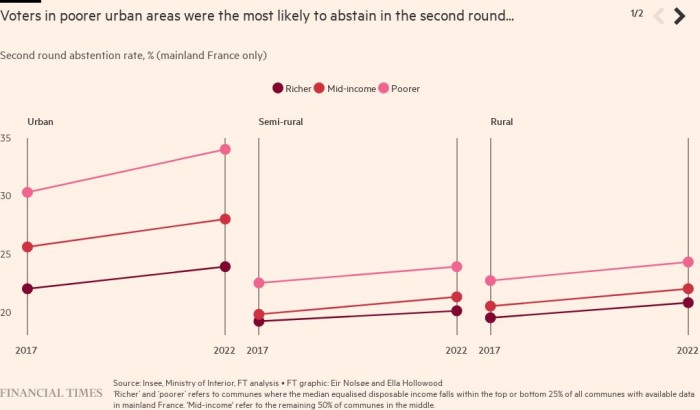Emmanuel Macron’s election victory over Marine Le Pen in charts
Emmanuel Macron has secured another term as president, beating far right challenger Marine Le Pen by 58.5 per cent to 41.5 per cent. Macron’s victory makes him the first president in 20 years to secure a second term in the Elysée Palace.
But despite winning with a much more comfortable margin than the polls predicted only a few weeks ago, Macron’s lead shrank nearly 8 percentage points compared with his 2017 victory.
Here is what the second round voting reveals.


How did Macron secure his victory?
Macron’s wooing of supporters of far-left candidate Jean-Luc Mélenchon, who finished third in the first round of the election, was key to his win. While a large chunk of Mélenchon voters (45 per cent) abstained in the run-off, the remainder overwhelmingly favoured Macron over Le Pen — 42 per cent to 13 per cent, according to an Ifop exit poll.
Most voters who had supported rightwing candidate Valérie Pécresse and environmentalist Yannick Jadot in the first round also gave Macron their backing in the run-off. Meanwhile, and unsurprisingly, nearly all (78 per cent) of those who backed extreme-right candidate Eric Zemmour transferred their support to Le Pen.

Polling after the second round shows that Macron’s strongest supporters were the oldest and youngest voters. Three-quarters of those aged 65 and over voted in favour of him — the highest share among any age group. Support was also high among 18 to 24-year-olds, at 59 per cent. Other age groups were almost equally split between Macron and Le Pen.

Where did Macron lose the most votes?
Despite winning comfortably, Macron experienced setbacks across France compared with the last election. He lost support particularly in the centre and south-west.

Where did Macron lose most support among voter groups?
Macron lost support across all income groups in urban, semi-rural and rural areas.
Le Pen emerged as the more popular choice in poorer rural and semi-rural areas — a new development. She also made large strides with voters in mid-income areas outside cities, where she had nearly half of the vote. This suggests that her messaging on the cost of living crisis resonated strongly with voters across the board. Purchasing power consistently came out as the top concern among voters in opinion polls in recent months.
Macron still remains by far the most popular in richer areas and in cities, even if that support is not as strong as in 2017. While Le Pen has little support in rich urban areas, she has gained some ground among voters in wealthy semi-rural and rural areas.

Which communes switched allegiances?
In a quarter of France’s 35,000 communes, the candidate who received most votes in the second round on Sunday was different from five years ago. Of those communes that switched allegiance, the vast majority (97 per cent) switched from Macron to Le Pen and are characterised by higher-than-average levels of unemployment.

Which voters stayed at home on election day?
In the election second round 28 per cent of registered voters abstained — the highest rate since 1969, and a 3 percentage point rise over levels in 2017.
The high figure suggests that many voters either felt the result was not in doubt or that neither candidate represented their views. Abstention was significantly higher in cities and in lower-income areas. More than one in three registered voters in poorer urban areas abstained — an increase of 4 percentage points since 2017.

The areas with the highest abstention rates were also where the vote for Mélenchon was largest in the first round of the election. Both Macron and Le Pen struggle to connect with voters in poorer urban areas. While Le Pen performs well on cost of living issues, her anti-immigration stance and environmental policies are a poor fit with this demographic. Meanwhile, Macron has stronger environmental credentials but is perceived as a president for the rich and lacks trust among Muslim voters, of whom 69 per cent voted for Mélenchon according to polling, after the government passed anti-terror legislation seen as divisive.
For all the latest Business News Click Here
For the latest news and updates, follow us on Google News.
